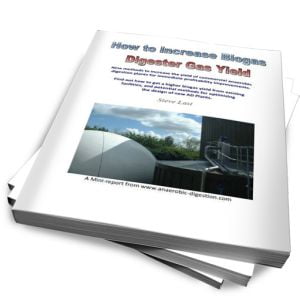In our opinion, the optimisation of biogas production for improved biogas yield should start with the consideration of the following list of factors which affect the fermentation tank for all wet Anaerobic Digestion Processes (e.g. Continuous Stirred Tank Reactors – CSTRs), and many also apply to dry AD methods as well.
This is important because biogas production is usually the main source of income from running an anaerobic digestion plant. Knowing how to increase biogas production, or correct slow-downs in its output for previously optimised AD plants is an essential skill for biogas plant operators.
8 Tips for the Optimisation of Biogas Production
1. pH Balance Maintenance
 Microorganisms are all sensitive to pH and in a biogas digester, each group lives most healthily at different pH ranges. maintaining the pH balance within certain ranges aids in the optimisation of biogas production.
Microorganisms are all sensitive to pH and in a biogas digester, each group lives most healthily at different pH ranges. maintaining the pH balance within certain ranges aids in the optimisation of biogas production.
It is an obvious starting point when considering how to increase biogas production because unless the pH is within a satisfactory range the microorganisms which produce biogas will not be able to grow at their optimum rate and produce methane efficiently.
They are classified for their optimum growth into acidophiles and alkalinophiles, however, most of these microorganisms do best in a neutral pH environment.
The methanogenic bacteria responsible for the production of methane metabolise best at pHs in the range of 6.5 to 7.2 (Wikipedia).
During the anaerobic digestion process, the pH is likely to drop due to the formation of volatile fatty acids (VFA) and this can affect the methane yield.
The acids responsible for causing the pH reduction are primarily acetic, propionic and butyric acid. Another factor affecting the pH drop is the H2CO3 alkalinity concentration from the production of carbon dioxide which becomes dissolved in the substrate.
Therefore, control and balance of pH, VFA and H2CO3 alkalinity need to be maintained.
So, the first step to ensuring optimum biogas production is to rigorously check that the systems used to monitor and adjust the pH are correctly set up. The pH metering system must be properly calibrated and the calibration checked regularly for drifting from accuracy to a false reading. By reference to the pH monitoring data, the digester feed should be adjusted as necessary to correct the pH as necessary. The bioreactor may need to be dosed with a pH correction chemical.
Alkali chemicals or a suitable acid may be added to maintain a pH within the design and commissioning optimums set at that time. making a change to bioreactor pH on-site should only be or by agreement with the AD plant process designer.
2. Temperature Control
 Temperature is a very important factor in any process as it influences the rate of reaction. Anaerobic digestion microbial activity is sensitive to temperature.
Temperature is a very important factor in any process as it influences the rate of reaction. Anaerobic digestion microbial activity is sensitive to temperature.
The rate of metabolism for microorganism growth falls into 3, temperature ranges, these being
- psychrophilic,
- mesophilic, and
- thermophilic.
The temperature range is set for your biogas plant at the design stage and should not be altered by site operational staff unless agreed with a process expert and the equipment has been built to operate at a higher temperature.
The Mesophilic temperature range has most often been used for anaerobic digestion since 2000, in the UK and Europe generally. Despite the fact that many people report faster biogas production when fermentation takes place in the hotter thermophilic range.
In cold and temperate climates the energy needed to heat up the feedstock, plus the additional heat lost from the hotter thermophilic reactor at that temperature range is significant.
Decisions to change the temperature range of a digester on-site should only be or by agreement with the AD plant process designer.
3. Inoculum (ISR)
Inoculum is the microorganism-rich mixture added into a digester to provide the microorganisms to drive the anaerobic digestion process. Providing the culture of the necessary bacteria (mostly archaea) for the fermentation is often called “seeding” the bioreactor.
Slurry from previous anaerobic digestion is usually the best inoculum to be used. Alternatively, use cattle, chicken, or pig manure, sewage sludge or suitable sludge from wastewater treatment plants can be used.
The ratio at which it is added in respect to the substrate is called inoculum substrate ratio or ISR. This ratio is very important as, if you were to get it wrong you can impede the complete digestion of the substrate. natural systems tend to self-correct for operator errors but time can easily lost waiting for the digester to recover.
Therefore, care in the operation of AD plants is necessary to avoid a biogas plant alternately cycling between high and low biogas yields respectively.
4. C: N Ratio – The Carbon to Nitrogen Balance
The mass ratio of C:N:P:S is about 100:10:1:1 in microorganism biomass, according to Wikipedia.
It is generally accepted that microorganisms use carbon 25 to 30 times more rapidly than nitrogen.
As a result, it is required that care is taken by carefully balancing the C: N ratio in the feedstock when the digester is fed.
The composition of the feed should be maintained so as to keep the C: N ratio in the digester tank within the desired range.
A low C: N ratio may result in ammonium inhibition, especially for nitrogen-rich substrates.
Ammonium has a varying level of toxicity to mesophilic methanogenic bacteria, which varies with pH. However, a C: N ratio above 30 slows down the life-cycle of microorganisms which results from the low formation of protein.
The optimum C: N ratio quoted online is generally thought to be in the range of 20 to 30 to 1.
5. Organic Loading Rate
The organic loading rate is the amount of solids (rate of feeding) added into the digester per unit volume per day and is normally described as the OLR, in units of kg VS/L. day.
The loading rate is used by the AD plant operator to decide on the amount (mass) of feedstock to be added to a digester per day, depending on the volume or size of the digester to yield the optimum (maximum) biogas output.
The knowledge of the OLR for a particular plant helps since feeding over the OLR doesn’t necessarily result in an increase in the gas produced. In one study to improve the biogas production for FVW , the best OLR was reported to be in the range 2.46 to 2.51 g/L. day for different digesters.
6. Hydraulic Retention Time
Hydraulic retention time (HRT) is the average time a solids or slurry particle spends in the digester during the anaerobic digestion process. HRT differs depending on the type of substrate and climate condition with which the anaerobic digestion is performed.
For example, tropical climate countries have shorter HRT between 30 and 50 days, whereas, in colder climates and cooler digesters, the necessary HRT can rise to as much as 100 days.
Longer retention times are needed because they allow time for the cells which have tough walls to be degraded. This allows the nutrients inside each cell to be released and eaten by the microorganisms. Long retention times also reduce the possibility of active bacterial population washout, though this may need a large volume digester.
CSTR HRTs are seldom less than 15 days.
7. Nutrients
Under certain circumstances, nutrients can play a vital role when considering the optimisation of biogas production. The bioreactor microorganisms require very small quantities of some elements known as “micronutrients” for their growth. Their presence can be crucial to maintaining a stable population within the microorganisms which perform anaerobic digestion.
Under normal circumstances when digesters are fed a variety of feed biomass the nutrients are readily available, but a nutrient addition may be needed. An exception, where additional trace nutrient is needed has often been found to be the anaerobic digestion of food waste.
Food waste digesters, solely fed with food waste, were found to run for a long period, maybe 1 to 2 years before mysteriously slowing down. Ultimately, most failed altogether and had to be emptied and restarted.
Adding manure was found to help, and research led by Southampton University AD experts in the UK found that food waste lacks necessary micro-nutrient trace elements. Over a long period of time, those elements tend to leave the bioreactor in the digestate output. When certain trace nutrients fall below a certain level the whole microbial community suffers.
Nitrogen, phosphorus, and trace elements such as calcium, sulphur, magnesium, potassium, nickel, iron, zinc, cobalt, copper and manganese are all nutrients which must be present in tiny quantities. If they are lacking the addition of these nutrients will lead to improved digester performance and that will normally result in increased biogas production.
The solution in this instance for optimisation of biogas production, is to regularly add the right trace nutrients. Many say they simply add some manure from their farm, but others buy and add proprietary trace nutrient-dosing products as recommended by the manufacturers.
8. Surface Area/ Particle Size
Particle sizes of the substrate and the presence of some fibrous materials may also have a significant influence on the gas production rate. It is, therefore, necessary that the particle size of the substrate be not too large as it may result in the digester clogging and difficulty experienced by the microbes in breaking down the substrate.
If the yield of a digester has deteriorated over a period and the reason for reading this article is to gain ideas on how to re-optimise your biogas plant for methane production it may be that the particle sizes of the substrate, have increased in some way or the fibrosity has risen without the operator being aware of that fact.
Once a digester's contents exceed a certain viscosity, possibly due to particle sizes rising or fibre build-up, the mixing system may simply become inadequate in power to re-mobilise the tank contents. To optimise the biogas production in these cases it may be necessary to add additional mixing capacity.
Doing this as a retrofitting exercise using a system such as the Landia GasMix may make sense. Such a system may possibly be able to re-mobilise the reactor contents and avoid a digester cleaning. Digester cleaning is expensive and results in loss of biogas production during re-commissioning unless large volumes of digestate can be stored and returned to the digester after cleaning.
Optimisation of Biogas Production – Conclusion
Increasing biogas production must always be the aim of all biogas plant operators, not only does optimisation raise the income from a digester, it also raises the sustainability of the process overall, for the good of all as a means of climate change abatement.
Whether raising biogas yield for a new biogas plant during commissioning, is one area in which it is hard to see any negative consequences. It is a win-win once optimisation is achieved, and as many experts have pointed out as any emitting cow routinely achieves many orders of magnitude greater biogas output than any mechanical digesters so far, there is massive potential for successful biogas optimisation.
Our tip list above omits some techniques used in the optimisation of biogas production. We know that. But, the above should in our opinion be considered before moving on to other techniques.
We wish you well with your optimisation efforts, and we welcome comments added to our comment box below. Rest assured that if you take the time to make a reasoned comment, we regularly review and approve your comments for publication.
In fact, these are just a few of the numerous methods we describe in our eBook “How to Increase Biogas Digester Gas Yields”. But more importantly, the eBook provides solutions rather than just suggested methods, as in the article above.
For more information on our eBook about How to Increase Biogas Plant Yield click here.
Text for items 1. to 8. above is based on: “www.ipcbee.com” with substantial amendments/ added text.






I ran a thermophilic digester site. I found that a ideal temperature for bugs was 131degrees. I also added bio char to my digesters to make me more methane. Be care what type of bio char you use. Everything worked great.
Interesting. Thanks for the information.
please how can i determine the right inoculum-substrate ratio and also the right quantity of water required to make a slurry. i am a post graduate student working on a research
The quantity of water to use is probably an amount which will be enough tomake a flowable slurry which will move well through the digester system. However, I think that the inoculum-substrate ratio would be more of a matter of using as much as possible within reason. Using less would I imagine just take a little longer for the system to reach full biogas production.